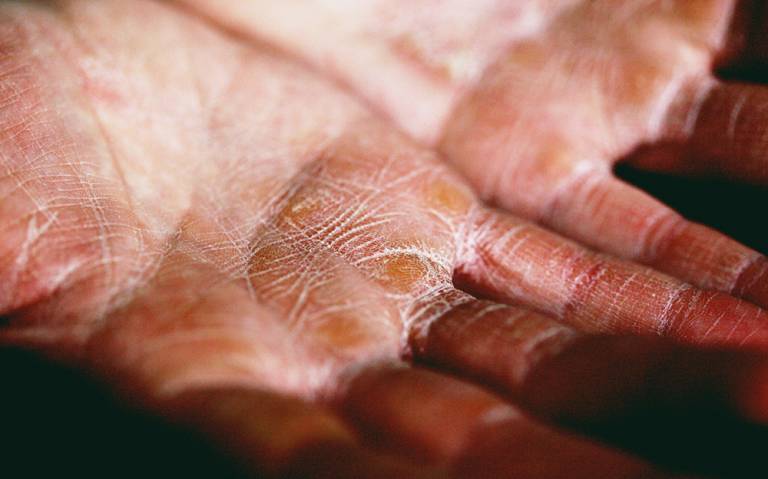New study helps to reshape the aftercare of patients recovering from graft-versus-host disease
4 August 2022
Researchers at UCL have been investigating how the skin’s immune system repairs the damage caused by graft-versus-host disease (GvHD).

A key concern for those undergoing blood cancer treatment is the risk of graft-versus-host disease. Up to 40 per cent develop the disease chronically, while up to 70 per cent see the signs acutely within the first few months of treatment. For some it is a temporary condition, but for others it can be chronic or even deadly.
Although there’s clear understanding of how GvHD develops, less is known about the long-term impact of the disease on the surrounding healthy skin. In a new study, researchers at the UCL Cancer Institute have explored this in detail and discovered more about how the skin reacts and changes after GvHD, helping those in recovery to make the right decisions about their ongoing treatment.
Understanding GvHD
GvHD is a complication of a bone marrow or stem cell transplant, where the donor graft reacts against the host’s cells. For many blood cancer patients, the skin is the most common area GvHD affects.
A type of white blood cell called T cells are present in donated stem cells or bone marrow. When these T cells meet patient cancer cells they kill them, which is an essential part of the treatment. However, the donated T cells sometimes see other healthy cells, such as those in the skin, as a foreign threat and attack them – this leads to GvHD. In some patients, chronic disease can cause permanent thickening and tightness of deeper skin tissues. Those with chronic GvHD might also have a higher risk of skin cancers.
The long-term impact on healthy skin cells
Our skin contains immune cells which ensure we’re protected against infections that can enter the body via cuts and wounds. But these immune responses need to be carefully controlled to make sure that we don’t react to harmless things in the environment. A specialised type of T cell called regulatory T cells create balance in the skin by moderating skin immune responses.
Skin GvHD can be treated but the long-term impact on the skin’s immune system is relatively unknown. Understanding this is especially important for those in recovery, as a poorly regulated immune response can cause further skin diseases.
UCL researchers have recently studied a laboratory model of GvHD, along with cells from a patient’s skin, and found that a population of immune cells called macrophages are activated when GvHD is present.
Dr Clare Bennett, Associate Professor in Immuno-haematology and senior author of the study, says “Macrophages maintain the self-regulation of the skin by repairing wounds, providing defence against cancer, stimulating hair regeneration and more. These cells are massively important but when they’re overactivated, they can cause serious inflammation.
“We were surprised to find that even when GvHD was gone in the study, the macrophages remained activated. After several weeks, we tested the regulatory T cells and found that they were unable to control the skin’s immune response when the activated macrophages were present, which can lead to contact dermatitis.”
Outcome
This study is hugely significant in how we treat patients who’ve been through GvHD. It strongly suggests that the cells which control the immune balance in the skin struggle to reset after GvHD, meaning many patients are more sensitive to skin diseases like contact dermatitis.
Moving forward, these findings shed light on the need to consider the long-term impact of immunotherapies on patients beyond recovery from primary disease.
Further information
- Research paper: Loss of T cell tolerance in the skin following immunopathology is linked to failed restoration of the dermal niche by recruited macrophages. Cell Reports
- Dr Clare Bennett academic profile
- Dendritic Cell Immunotherapy Research Group - Bennett Lab
- UCL Cancer Institute
- UCL Institute for Immunity and Transplantation
- Image: Eczema/contact dermatitis. Photo by Sharon McCutcheon on Unsplash
 Close
Close

